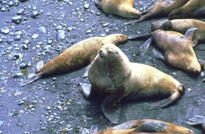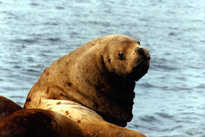Steller Sea Lion
(Eumetopias jubatus)
IUCN STATUS (2010) - ENDANGERED
| Distribution and Numbers Steller sea lions, also known as Northern sea lions, are the largest of the Otariidae (eared seals) and are distributed around the rim of the North Pacific Ocean from California to northern Japan. It was estimated in 2000 that the total range-wide number of Steller sea lions was roughly about 85,000, down from an estimated 240-300,000 in 1960. The world-wide population is generally divided into two stocks, based largely on genetic evidence, namely the "western population" (Gulf of Alaska, Bering Sea, Russia and small numbers in Japan) and the "eastern population" (California, Oregon, British Columbia and Southeast Alaska). Individuals have been known to wander as far south as the Bohai and Huanghai Seas in China. |
| Status Although the eastern population has remained stable at an estimated 39,000 for the last few years, the western population of Steller sea lions has been declining rapidly in recent years, from an estimated total of 227,000 in 1960 to one of 45-46,000 in 2000. In 1997 the U.S. population of the Steller sea lion west of 144°W (Cape Suckling, Alaska) was reclassified as Endangered under the Endangered Species Act, the remainder of the population remaining classified as Threatened, a status it has held since 1990. The species is also listed as Depleted under the U.S. Marine Mammal Protection Act, protected from intentional killing in Canada by the Fisheries Act, and listed as Endangered on the IUCN Red List. |
 Photo: Rolf Ream, National Marine Mammal Laboratory |
| The exact cause of the decline in the western population of Steller sea lions, which has been observed in both U.S and Russian waters, is unknown. One possibility however is that it may be due to localised depletion (either in time or space) of food resources, particularly in winter, caused by intensive commercial fisheries for groundfish. It is thought that between 50-80% of recent trawl fishery catches of key Steller sea lion prey species in the U.S. have come from the sea lion's critical habitat. In December 1998 an official U.S. government Biological Opinion concluded that the walleye pollock fisheries off Alaska, as currently managed, are likely to jeopardise the continued existence of the western population and to adversely modify its critical habitat. An additional Biological Opinion produced in December 2000 concluded that, while other factors are also contributing to the decline in sea lion numbers, competition with fisheries in the Bering Sea, Aleutian Islands and Gulf of Alaska that target their most important food resources is a significant factor in their decline. It further concluded that continued fishing for groundfish, including pollock, Atka mackerel and Pacific cod, under existing rules is likely to jeopardise the western population of Steller sea lions and to adversely affect their critical habitat. |
| No-trawl buffer zones of 10nm (nautical miles) and 20nm around various Steller sea lion rookeries have been established by the U.S. since 1990. Transit within 3nm of rookeries west of 150°W is also banned all year round. In 1999 and 2000 the U.S. government issued emergency interim rules expanding the number of seasonal and year-round pollock trawl exclusion zones around important rookeries and haulouts. The rules also implemented measures to disperse pollock fishing effort, both temporally and spatially, and closed the Aleutian Islands to pollock trawling. Further restrictions were placed on the Aleutian Islands fishery for Atka mackerel, an important Steller sea lion prey species in some areas. |
| Environmental groups, arguing that these actions are insufficient to adequately protect the habitat and food supply of the species, have been pressing the U.S. government to restrict the fisheries even further. In July 2000 a U.S. federal court, in response to an ongoing court action brought by three environmental groups, ruled that the government had to implement immediate and significant changes to groundfish trawl fisheries in Alaska in order to protect Steller sea lions from loss of prey. The provisions of the decision included the banning of all groundfish trawl fishing within 20nm of designated Steller sea lion critical habitat rookeries, haulouts and feeding areas, and took effect from August 2000 until the government could produce the Biological Opinion in December 2000. Controversy ensued in November-December 2000 when an Alaskan Senator, in conjunction with the fishing industry and despite a great deal of opposition by environmental groups, introduced a "rider" to a U.S. Congress appropriations bill which prevented the full implementation of the management measures recommended by the new Biological Opinion and limited the government's ability to restrict the fisheries. |
| Deliberate killing by fishermen is still a threat throughout the species' range. There is also conflict with fish farms in Canada, 87 Steller sea lions being killed legally under predator control permits by the British Columbia fish farming industry in 1999, mostly in the Vancouver Island area. It is thought that other sea lions are also being killed illegally by fish farmers. Commercial hunting, which took large numbers of the sea lions until as recently as the 1970s, no longer takes place. There is an average subsistence kill of 412 Steller sea lions in Alaska each year, almost all from the western population and the majority taken by Aleut hunters in the Aleutian and Pribilof Islands. There is also some mortality of the western population of Steller sea lions in the U.S. due to entanglement in commercial fishing nets, an estimated average minimum of 30 sea lions killed each year, the real figure possibly much higher. These two causes of mortality are significant given the precarious state of the western population. Steller sea lion numbers have been declining in recent years in the southern end of the species' range in central California where habitat concerns include reduced prey availability, contaminants and disease. |
| Steller sea lions in Alaska may have been affected by the 1997-98 El Nino although it is not known yet to what extent. Environmental changes in the Bering Sea ecosystem, such as warmer ocean temperatures, altered ocean currents and atmospheric conditions, may also be affecting the species. There is also a danger to Steller sea lions from vessels running aground in their habitat, although the species is not as vulnerable to oil-related injuries as sea otters or sea birds. In May 1999 a 24-metre fishing vessel ran aground on the rocks of Unimak Island in the Aleutian Islands, the coastguard saying that they expected the vessel to lose all 30,000 litres of diesel, lubricating and hydraulic oils which it was carrying. In the same month a 54-metre freighter carrying 420,000 litres of fuel oil ran aground at the entrance to Cold Bay, east of Unimak Island, leaking up to 400 litres of lubricating oil. A number of Steller sea lion haulout and rookery sites were affected by the Exxon Valdez oil spill in Prince William Sound, Alaska, in 1989 but inadequate data exists to determine the impact of the spill on the population. High levels of the antifouling paint tributyltin (TBT) have been found in Steller sea lions around Hokkaido. |
 Photo: National Marine Mammal Laboratory |
Lifestyle The Steller sea lion breeding season is from mid-May to mid-July and individuals appear to have a high fidelity for their breeding rookery. Dominant males arrive early to establish territories on the rookeries, located on exposed rocks and beaches. Females give birth to a pup usually about 3 days after arriving at the rookery. The pup is born with a thick dark brown coat which it will moult for a lighter brown coat after 4-6 months, and which will eventually be replaced by the adult coat, a light tan to reddish-brown colour, slightly darker on the front. About 9 days after giving birth the mother leaves to feed at sea, beginning a cycle of 1-3 days feeding at sea and 1-2 days nursing her pup on land. |
| The time that the mother spends feeding at sea increases over the nursing period. About 11-14 days after giving birth the mother mates. Most pups are nursed for a year but in some cases can be nursed for up to 3 years. Juvenile and non-reproductive Steller sea lions moult in July and August, followed by nursing mothers and finally by the adult males in late autumn. Many rookeries have adjoining haulouts and some rookeries are also used as haulouts after the breeding season. |
| Some Steller sea lions, especially juveniles and adult males, disperse widely outside the breeding season, travelling hundreds and even thousands of kilometres. There appears however to be only a limited exchange between populations. Steller sea lions are opportunistic feeders, foraging mostly near the shore and over the continental shelf for fish, including walleye pollock, herring, capelin, mackerel, rockfish and salmon, and cephalopods such as squid and octopus. In the Pribilof Islands young male Steller sea lions have been observed killing and eating Northern fur seal pups while elsewhere they have been observed eating the occasional harbour and ringed seals. Predators include sharks and killer whales. Predation by Arctic foxes on pups has also been observed in the Russian Commander Islands. |  Photo: Rolf Ream, National Marine Mammal Laboratory |
Statistics
Adult males measure an average 2.8m (maximum 3.2m) in length, and weigh an average 566kg (maximum 1,120kg), while females are smaller at 2.3m (maximum 2.9m) in length, and 263kg (maximum 350kg) in weight. Pups are born measuring about 1m in length and weighing 16-23kg. Females reach sexual maturity at 3-8 years of age, males at 3-7 years of age. Most territorial bulls are between 9-13 years of age. A Steller sea lion has been observed diving to a depth of over 400m. Females can live up to 30 years of age, males up to about 20 years.
